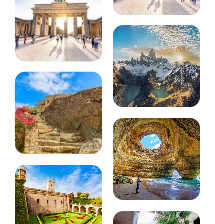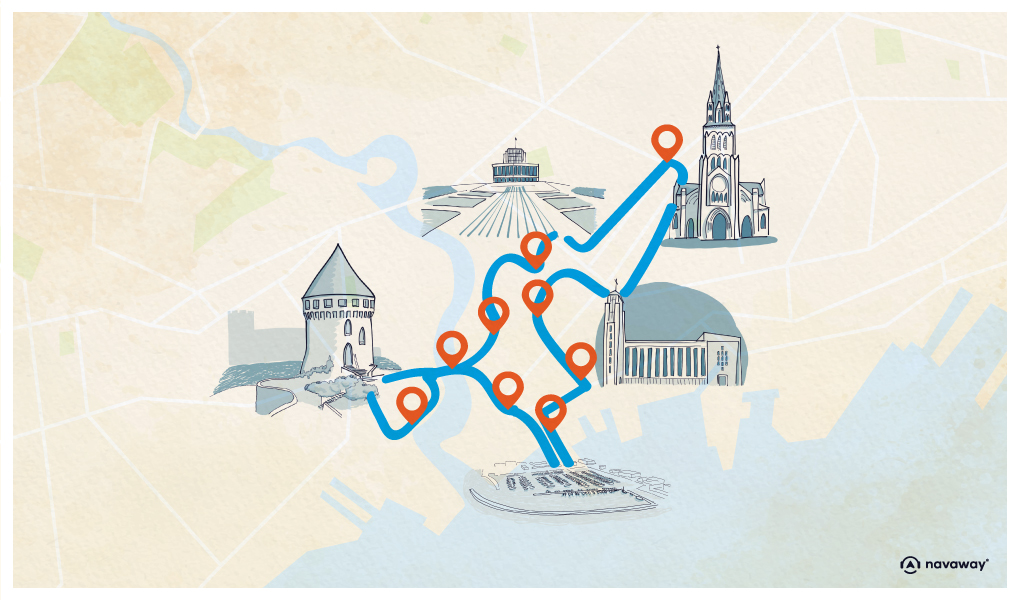
Pink Granite Coast: 12 must-see places in Brittany
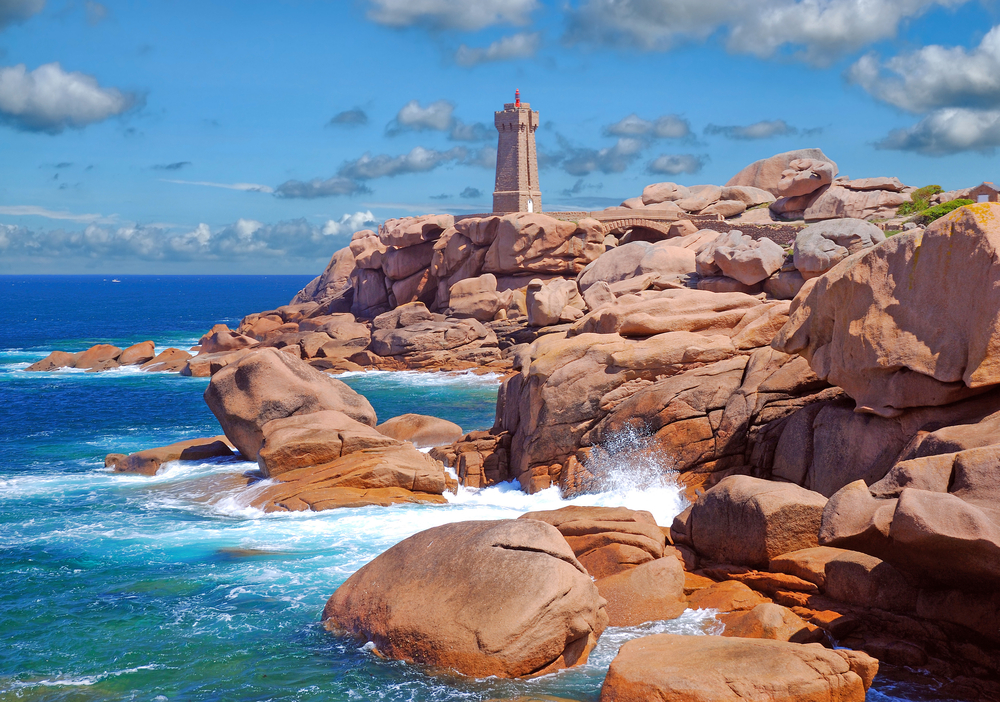
The Pink Granite Coast, located in the Côtes-d’Armor region of Brittany, offers a natural spectacle that is unique in the world. This geological marvel stretches for some fifteen kilometres between Perros-Guirec and Trébeurden, where imposing pink-tinged granite rocks shaped by erosion create enchanting landscapes. Ranked as one of the most beautiful coasts in the world, it boasts an exceptional coastline dotted with beaches, wild coves and spectacular rock formations. Whether you’re a nature lover, keen hiker or simply looking for an escape, the Pink Granite Coast promises an unforgettable experience. Here is our selection of 12 must-see places to discover during your stay in this Breton jewel.

See also the Brittany guide :
- 10 must-see places to visit in Brittany
- Discover Brittany’s most beautiful lighthouses
- 12 unusual romantic weekends in Brittany
- The 22 must-see things to do in Cotes-d’Armor
- The most beautiful villages in Brittany
- 12 places to spend an unusual night in Brittany
- Top 20 of Brittany’s most beautiful beaches for swimming this summer
- The most beautiful villages to visit around Brest
- The 14 most beautiful walks around Saint-Malo
- Top 6 of the best seaside campsites in Brittany
1. Ploumanac’h and its Mean Ruz lighthouse
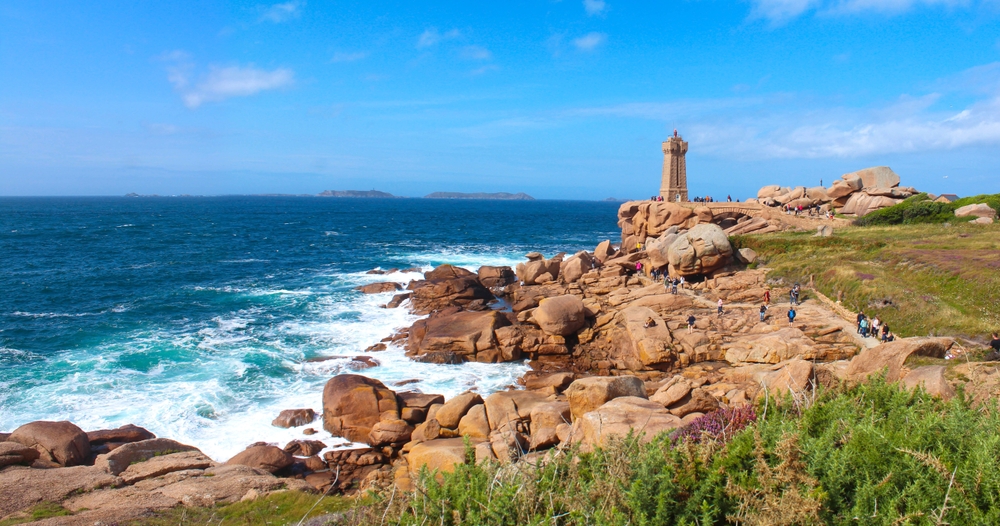
Voted France’s Favourite Village in 2015, Ploumanac’h is the beating heart of the Pink Granite Coast. This hamlet of Perros-Guirec boasts a spectacular coastline where granite chaos carves out extraordinary landscapes. The famous Mean Ruz lighthouse, built of pink granite in 1948, stands majestically amidst these thousand-year-old rock formations. Standing 15 metres high, this emblematic sentinel marks the entrance to Ploumanac’h harbour and offers an exceptional panorama of the Sept-Îles archipelago.
The surprisingly shaped rocks have evocative names such as Napoleon’s Hat, the Rabbit and the Mushroom. At sunset, the pinkish hue of the granite glows in the golden rays, creating a magical atmosphere. Don’t miss the beach of Saint-Guirec and its oratory dedicated to Saint Guirec, a romantic spot where legend has it that young women came to prick a needle in the statue’s nose to find a husband within the year.
2. The customs trail (GR34)
The sentier des douaniers, part of the legendary GR34, is one of the most beautiful walks in Brittany. The 8-kilometre round trip between Perros-Guirec and Ploumanac’h winds along the coast, offering breathtaking views of the pink granite rocks. This coastal path, once used by customs officers to keep an eye on smugglers, takes you through a veritable open-air museum where nature has sculpted monumental works of art.
The walk generally starts from Trestraou beach in Perros-Guirec and follows the coastline to the port of Ploumanac’h. Along the way, you’ll discover secret coves, fine sandy beaches and lush vegetation of moorland, gorse and heather. Viewpoint after viewpoint, each more spectacular than the last. Allow around 2 to 3 hours to make the most of this walk, which is accessible to all, preferably at low tide to admire the rocks in all their splendour.
3. The Sept-Îles archipelago
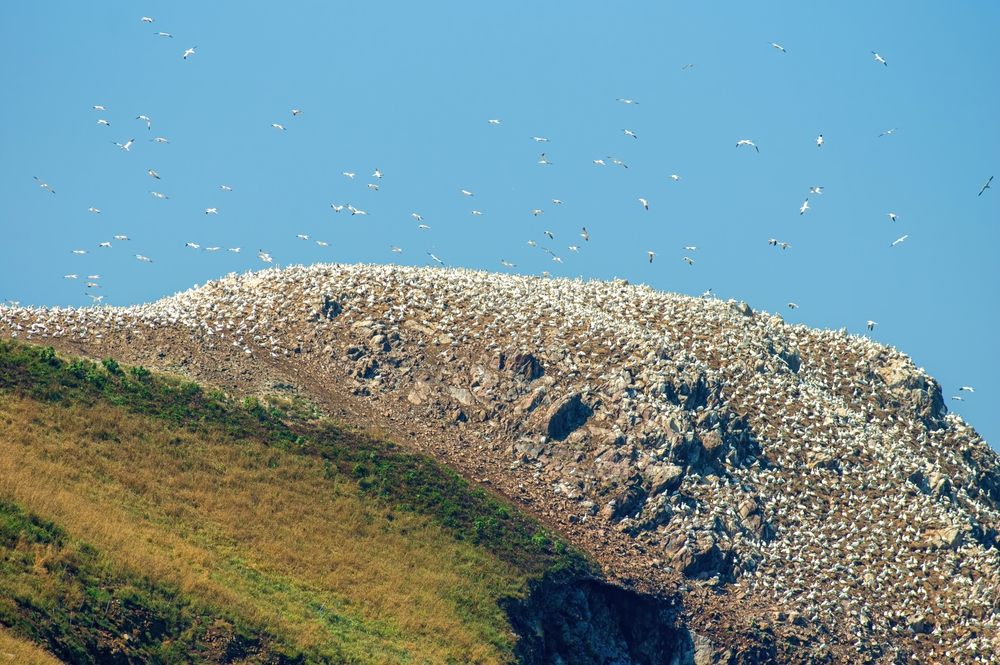
Off the coast of Perros-Guirec, the Sept-Îles archipelago is the largest ornithological reserve in mainland France. Classified as a nature reserve since 1976, this protected area is home to more than 27,000 pairs of seabirds, divided into 27 different species. The Sept-Îles are world-famous for being home to France’s only colony of gannets, with more than 24,500 pairs, as well as the only colony of puffins in mainland France, those endearing birds with colourful beaks nicknamed “sea parrots”.
Boat trips depart from Perros-Guirec or Trégastel to discover this fascinating archipelago. Ile aux Moines is the only island open to visitors, with a 2-kilometre marked trail for observing birds in their natural habitat. The best time to see puffins is from April to July, before they migrate offshore. The guided cruises offer fascinating explanations of the fauna, flora and history of these mysterious islands, true sanctuaries of biodiversity.
4. The Trégastel marine aquarium
Nestling in the heart of an exceptional granite chaos, the Trégastel marine aquarium offers a unique experience. Housed in natural caves carved out from beneath imposing boulders of pink granite, this atypical aquarium lets you discover the wealth of local marine fauna in a spectacular setting. The first room is under a 5,500-tonne block of granite measuring 22 by 15 metres, an impressive architectural feat.
The aquarium features around fifty marine species in their natural, reconstructed environments: the Spray, the Pools and the Deep. You can see the famous Breton lobster, dogfish, sea bass, conger eels and many other inhabitants of the Channel seabed. Educational activities and group outings are organised on a regular basis. Located just 50 metres from the Coz-Pors beach, the Trégastel aquarium is a must-see for families. (Boulevard du Coz-Pors, 22730 Trégastel, rated 4.2/5 on Google for over 1,200 reviews)
5. The Plougrescant chasm and Castel Meur
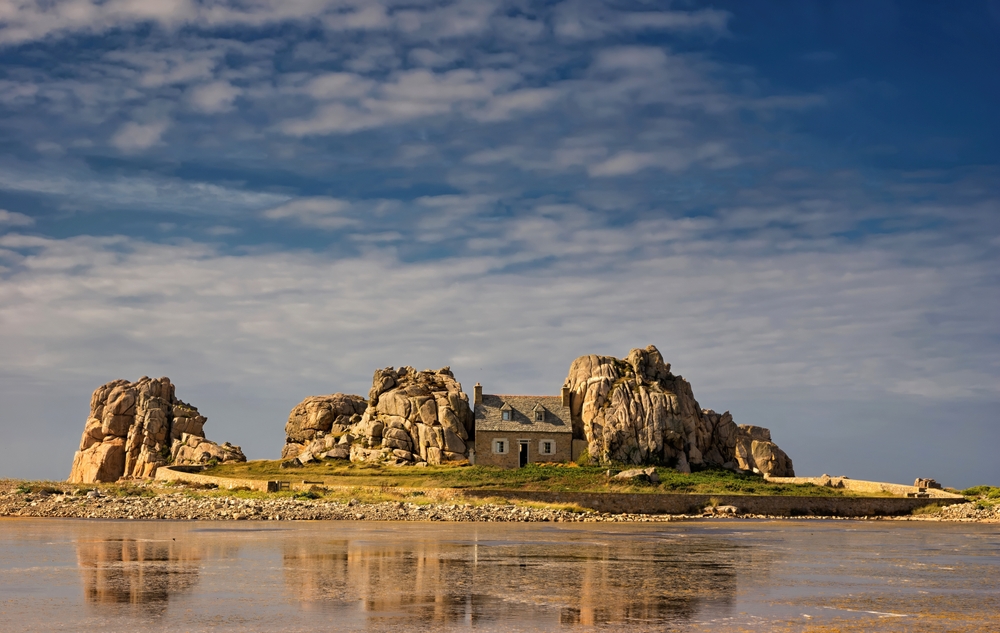
The Plougrescant chasm is one of Brittany’s most photographed spots. This impressive rift between two rocks fills up with a bang during high tides, offering a breathtaking visual and audio spectacle. But it is above all the famous “house between the rocks”, known as Castel Meur (“great castle” in Breton), that catches the eye. Built in 1861 between two huge blocks of granite, this little stone house defies the imagination with its unusual location.
Legend has it that its owner wanted a home sheltered from the violent winds of Brittany’s coastline. Now privately owned and inhabited, Castel Meur has become a symbol of the Pink Granite Coast, immortalised by thousands of visitors every year. A coastal path leads to the site from the Pors Scaff car park. The 20-minute walk takes you through a wild, unspoilt landscape typical of this stretch of Brittany’s coastline. Please respect private property and just admire the house from the path. (Lieu-dit Castel Meur, 22820 Plougrescant)
6. Perros-Guirec and its beaches
Perros-Guirec is a must-see seaside resort on the Pink Granite Coast, with its magnificent beaches and flower-filled town centre. Trestraou beach, the largest in the commune, stretches over 800 metres of fine sand bordered by a beautiful promenade. Very lively in summer, it offers all the necessary services: sailing clubs, kayak hire, restaurants and shops. The more intimate Trestrignel beach nestles in an unspoilt natural setting between the rocks.
Stroll through the flower-filled lanes of the town centre, particularly along Boulevard Aristide-Briand and Place de l’Hôtel de Ville. The Belle Époque casino, built in 1925, bears witness to this resort’s prestigious past. Don’t miss the Perros-Guirec marina, one of the largest on Brittany’s north coast, where excursions to the Sept-Îles depart. The semaphore, located on the heights, offers an exceptional panorama of the bay and the archipelago. The town also hosts numerous cultural events, including the famous Jazz Festival in July.
7. Trégastel and its sculpted rocks
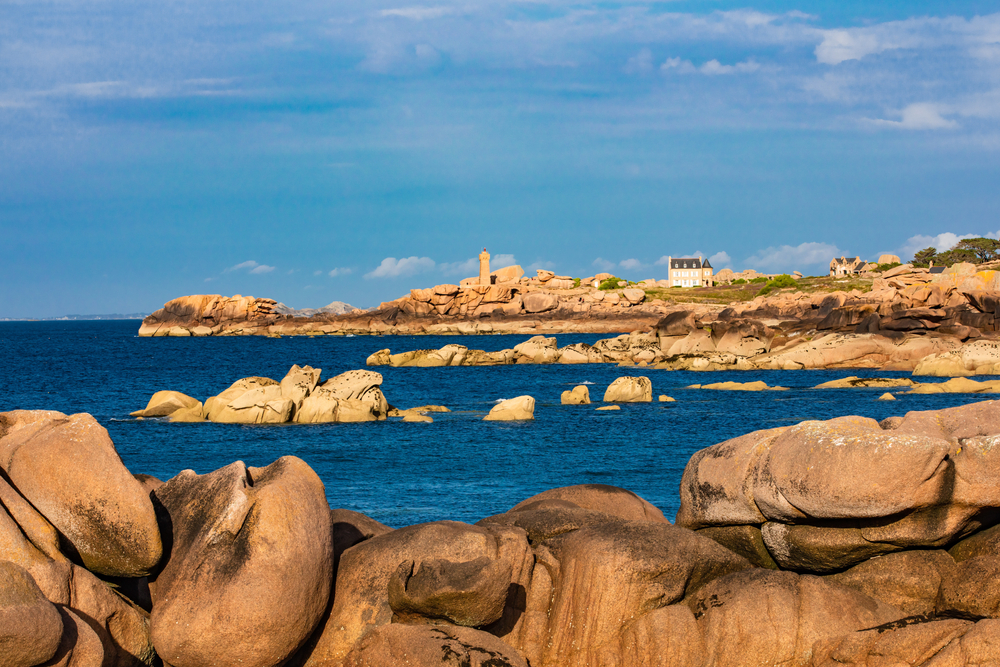
Trégastel boasts one of the most beautiful granite rock formations on the Pink Granite Coast. The site of the sculpted rocks, accessible from the Coz-Pors beach, boasts an impressive concentration of rock formations with evocative shapes. Le Dé, La Pile d’Assiettes, La Tortue, Le Tas de Crêpes: these granite giants with amusing names stimulate the imagination and offer an extraordinary natural playground.
The Renote peninsula, linked to Trégastel by a narrow road, offers a circular walk of around 2 hours through a landscape of moors, rocks and secret coves. The Trégastel forum, a cultural and tourist centre on the seafront, hosts exhibitions and provides information on the region. Trégastel’s beaches, particularly Grève Blanche, are renowned for their beauty and the quality of their water. The town also organises a night market in summer, an ideal opportunity to discover local produce in a friendly atmosphere.
8. Lannion, capital of Trégor
With a population of 20,000, Lannion is the centre of the Pink Granite Coast. This historic town, which has been awarded the Ville d’Art et d’Histoire (Town of Art and History) label, boasts a remarkable architectural heritage. The remarkably well-preserved medieval centre boasts sumptuous 15th and 16th century half-timbered houses, notably around Place du Général-Leclerc and Rue des Chapeliers. The church of Brélévenez, perched on a hill, dominates the town and offers an exceptional panoramic view after climbing its 142 steps.
The old town of Lannion can be explored by strolling along the banks of the River Léguer, where old wash-houses and the picturesque medieval bridge of Kermaria still stand. The Augustine convent, now a cultural centre, and the Ursuline convent bear witness to the town’s rich religious past. Lannion is also home to the Cité des Télécoms, an interactive museum retracing the history of telecommunications, housed in the pink radome of the historic Pleumeur-Bodou site. On Thursdays, the large weekly market livens up the town centre with its stalls of authentic Breton produce.
9. The Traouïero valley
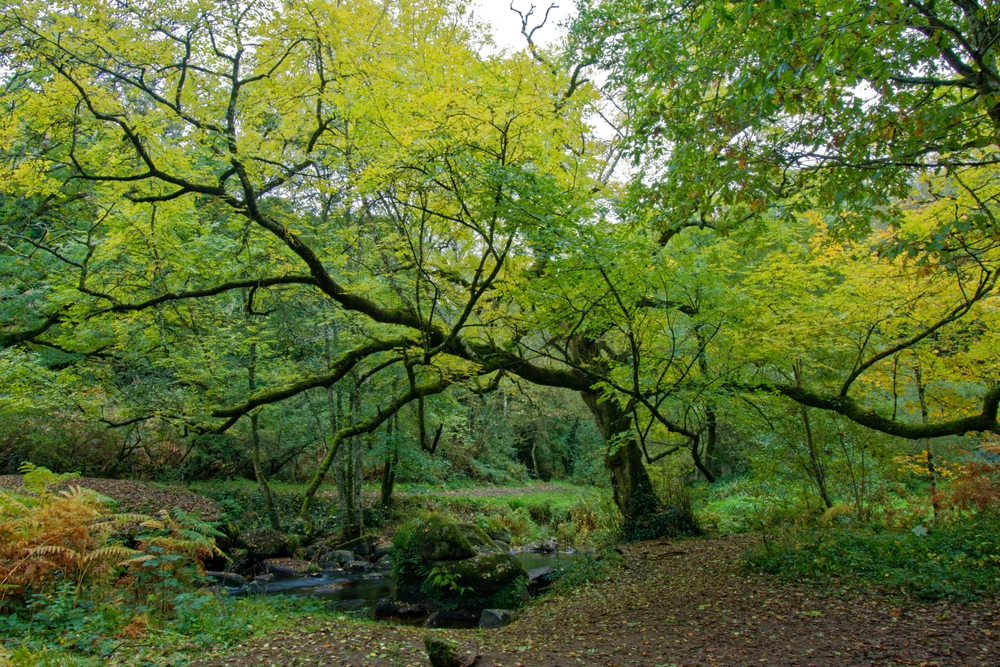
A veritable treasure chest of greenery, the Traouïero valley offers a striking contrast with the coastline. This unspoilt natural site, located between Perros-Guirec and Trégastel, is a harmonious blend of deciduous forests, granite chaos, streams and ponds. A signposted 5 or 10 kilometre trail, depending on the route chosen, takes you through this enchanted valley where an almost mystical atmosphere reigns.
The route winds beneath centuries-old oaks and majestic beech trees, crossing picturesque stone bridges and skirting mossy granite walls. The boulders, sometimes perched in precarious balance, create caves and narrow passages that will delight children. The valley is home to some remarkable flora, including giant ferns and, in spring, a carpet of wild daffodils. It is also a popular spot for birdwatchers, with many species of forest birds. This walk, which is accessible to all, is a rejuvenating nature break just a few minutes from the coast.
10. Trébeurden and the pointe de Bihit
Tréburden, a charming seaside resort nestling in a protected bay, marks the western end of the Pink Granite Coast. The town is renowned for its fine sandy beaches, including Tresmeur beach, ideal for families, and the wilder Goas Treiz beach. The Le Castel peninsula, accessible at low tide, offers a breathtaking walk among the rocks and moorland.
The Pointe de Bihit, to the west of Trébeurden, is one of the most beautiful lookouts on the coast. This rocky outcrop offers an exceptional 360-degree panorama over the Bay of Lannion, the Sept-Îles archipelago to the north and the Milliau and Molène islands to the south. The coastal path leading to it crosses moorland dotted with heather and golden gorse. Beware, some passages require caution and vigilance, particularly in windy conditions. The sunset from the Pointe de Bihit is a magical moment, when the pink granite glows in the last rays of the day and the Mean Ruz lighthouse stands out on the horizon. (Pointe de Bihit, 22560 Trébeurden)
11. Ile Grande and its coastal path
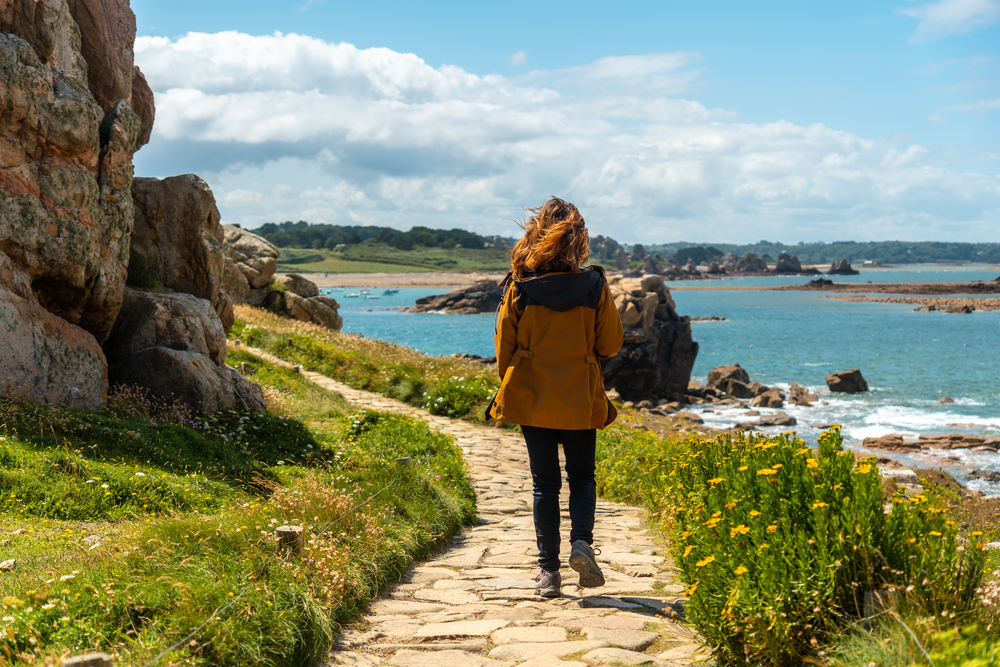
Linked to the mainland by a dike road, Ile Grande offers an unspoilt natural setting just a stone’s throw from Pleumeur-Bodou. This former island, now a peninsula, has an authentic character with its fishermen’s cottages, small port and peaceful beaches. The complete tour of Ile Grande takes less than 3 hours via a signposted coastal path that forms an integral part of the GR34.
The route reveals a variety of landscapes: secret coves, pebble beaches, sculpted rocks and wild moors. Don’t miss the covered alley at Crec’h Quillé, a 4,000-year-old megalithic vestige, and the LPO (Ligue pour la Protection des Oiseaux – League for the Protection of Birds) station, which offers exhibitions on seabirds and organises ornithological outings. Ile Grande is also the starting point for sea kayaking trips to explore the surrounding area. Its tranquil, authentic atmosphere makes it a refreshing break from the tourist crowds of the nearby seaside resorts. The village has a number of restaurants and crêperies where you can sample Breton specialities.
12. Brittany Planetarium
Located in Pleumeur-Bodou, close to the famous radome, Brittany’s planetarium offers a different kind of escape: a journey into the universe. This cutting-edge scientific facility offers immersive shows under a dome 20 metres in diameter, where high-definition digital images of space, planets and galaxies are projected. Thanks to a high-performance projection system, you can embark on a fascinating exploration of the cosmos.
Themed sessions, suitable for all ages from 7 upwards, cover a wide range of subjects: the solar system, the constellations, the history of astronomy, the latest discoveries in space and the lives of astronauts. Special events are organised to mark astronomical milestones such as eclipses and comet transits. The planetarium also organises star-gazing evenings with telescopes, weather permitting. It’s the perfect way to round off your discovery of the Pink Granite Coast, with an escape into infinity that will delight young and old astronomy fans alike. (Route de Trébeurden, 22560 Pleumeur-Bodou, rated 4.5/5 on Google out of 1,800 reviews)
In conclusion, the Pink Granite Coast offers a diversity of landscapes and experiences that make it a must-see destination in Brittany. Between sea and land, wild nature and cultural heritage, each place reveals its own share of magic. Whether you’re a keen walker, a geology enthusiast, a birdwatcher or simply in search of beauty, this legendary coastline will win you over. Take the time to stroll along the coastal paths, watch the play of light on the pink rocks at sunset, breathe in the iodised air and soak up the very special atmosphere of this land where nature has created a monumental work of art. The Pink Granite Coast will leave you with unforgettable memories and, as the Breton saying goes, “those who come, come back and those who come back, stay”.
FAQ
When is the best time to visit the Pink Granite Coast?
The ideal period is from May to September, with a preference for June and September to avoid the summer rush. Spring brings magnificent blooms on the moors, while autumn offers exceptional light. To see puffins in Sept-Îles, choose the period from April to July.
How long does it take to visit the Pink Granite Coast?
A weekend will allow you to discover the main sites, but a stay of 4 or 5 days is ideal for making the most of the region, hiking the coastal paths, visiting the islands and exploring the hinterland. This will also give you time to adapt to the tides and make the most of the beaches and natural sites.
Is the customs path accessible to all?
The main section between Perros-Guirec and Ploumanac’h is accessible to walkers of all abilities, including families with children. The trail has a few ascents and descents, but is still passable. However, some of the more technical sections, particularly towards the pointe de Bihit, require special attention and are not recommended for people with reduced mobility.
Where can I park to visit Ploumanac’h?
There are several car parks in Ploumanac’h (for which a charge is made in high season): the Saint-Guirec beach car park, the Mean Ruz lighthouse car park and the Trestraou beach car park in Perros-Guirec. In high season, it is advisable to arrive early in the morning or late in the afternoon to find a space. Free shuttle buses run between the various sites in summer.
Can you swim on the Pink Granite Coast?
Yes, many beaches are suitable for swimming, including Trestraou, Trestrignel and Saint-Guirec in Perros-Guirec, as well as the beaches at Trégastel and Trébeurden. However, beware of tides and currents, and check the bathing conditions posted on the beaches. Several beaches are supervised in summer by lifeguards.
200 audioguided tours for cities all around the world
Download